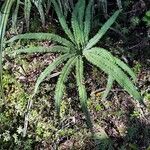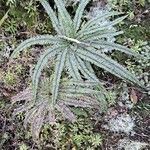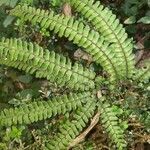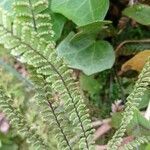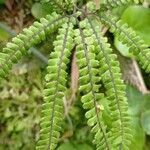Rhizome short-creeping, sparsely to richly stoloniferous, c. 3 mm. diam.; scales concolorous, pale or dark brown, with entire margin. Fronds tufted or occasionally scattered along a stolon, 5–70 cm long. Stipe to 45 cm long, dull, together with rachis clothed with antrorse red-brown hairs. Lamina 2–3-pinnate and ±triangular, or helicoid and very broadly ovate to obovate (sometimes with a palmate appearance), 5–30 cm long, 3–25 cm wide, herbaceous to coriaceous. Pinnae narrowly triangular to elliptic. Pinnules at the base of pinnae symmetric and depressed-obovate to flabellate, otherwise dimidiate and rectangular to subtrapeziform; distal margins shallowly lobed, dentate when sterile; surfaces pubescent (rarely glabrous); hairs erect or lax, pale, 1–4-celled. Sori 1–20 per pinnule, along distal margins, 1–4 per lobe; soral flaps oblong or subrectangular, setose, each at the base of a narrow sinus; setae dark brown. Spores to 32 per sporangium, brown, outline in polar view triangular to convex-triangular; aborted spores usually numerous; perine finely granulate, loosely adhering to exine. '
Stems short-creeping; scales dark reddish brown, concolored, margins entire. Leaves arching, clustered, 20--37 cm. Petiole 1--2 mm diam., adaxially hispid, not glaucous. Blade lanceolate, pinnate or occasionally pseudopedate, 1-pinnate distally, 12--18 × 6.5--8 cm; proximal pinnae 1--4-pinnate; indument of light-colored, sparse, multicellular hairs; rachis straight, densely hispid, not glaucous. Segment stalks 0.2--0.3 mm, dark color generally entering into segment base. Ultimate segments oblong to long-triangular, ca. 2 times as long as broad, progressively reduced toward apex of penultimate divisions; basiscopic margin oblique; acroscopic margin of fertile segments crenulate, sterile segments sharply denticulate; apex obtuse or acute. False indusia ± round, 0.6--0.9 mm diam., covered with reddish brown, stiff, needlelike bristles. Spores mostly 40--60 µm diam.
Rhizome stout, shortly creeping; stipites clustered. Stipes us. stout, scabrid, very dark brown, shining, 15-30-(40) cm. long; clad in greyish pubescence when young. Rhachis rather stout; densely clad, at least when young, in hispid hairs. Costae hispidulous. Lamina 15-35 × 10-30 cm., broadly flabellate, dark olive green (pink to red when immature), firm, glab. to ± hispid; divided into (5)-10-(15) branches. Primary pinnae 7-20 × 1-3 cm., about lanceolate-acuminate. Secondary pinnae up to 15 × 5 mm., dimidiate-oblong to dimidiate-rhomboid, very shortly stalked, very close-set; lower margin entire, upper with numerous small crenate teeth. Sporangia 10-15 groups per pinnule, close-set, in sinuses, protected by lunulate to reniform reflexed margin 1-2 mm. long.
Rhizome short, erect to procumbent, set with castaneous, lanceolate, entire rhizome-scales up to 1.5 mm long. Fronds tufted, erect, pedate or repeatedly unequally dichotomously divided; stipe castaneous, hispid, up to 290 mm long; lamina approximately deltate, up to 240 x 200 mm, repeatedly dichotomously divided into up to 8 linear pinnae up to 200 mm long; pinnules mostly rhombic, becoming reduced and obcuneate towards pinna apex, firmly herbaceous, dark green, thinly hispid on under surface only, up to 10 x 6 mm; rhachis castaneous-hispid with pale stiff hairs up to 0.5 mm long. Sori borne on acroscopic and outer margin of pinnules; indusial flaps pilose, round to oblong, up to 1 mm in diameter.
Rhizomes short-creeping or ± erect, scaly. Stipes and rachises stiffly hairy. Laminae broadly ovate to ± orbicular, 12-30 × 10-25 cm, usually pedate, sometimes (2)-3-pinnate, divided into 5-15 branches to 20 cm long and bearing up to 40 pinnules on each side. Ultimate pinnules ± oblong or parallelogrammoid, 5-15 × 3-6 mm; stalk attached at proximal corner; upper and outer margins finely toothed, lower and inner margins entire; upper surface glabrous, lower hairy, both surfaces dark green at maturity but red-tinged when young. Indusia ± reniform with shallow sinuses, hairy, up to 22 per pinnule on upper and outer margins, often extending to inner margin.
Perennial with short rhizome. Fronds erect, pedate, stipe hispid, lamina deltate, repeatedly dichotomously divided with up to 8 linear pinnae, pinnules rhombic, hispid beneath. Sori on acroscopic outer margin of pinnules, indusial flaps pilose, rotund to oblong.
Rhizome erect to procumbent, set with rhizome scales up to 1.5 mm long. Fronds 2-or 4-pinnate, repeatedly and unequally dichotomously divided. Pinnules mostly rhombic, upper and outer margins irregularly crenate-dentate.
